Working With Excel 2000 and Excel 97 Reports
EXL2K format generates styled reports in Excel 2000
HTML format for use on other platforms and on the Web. Feature options
enable FOCUS users to also download all fields mentioned in their
requests in an Excel PivotTable, or include interactive Excel formulas
for FOCUS aggregation operations for performing additional "what
if" analyses on their data within Excel 2000.
EXL97 is an HTML-based HOLD format for generating formatted Excel
97 spreadsheets. EXL97 is a full StyleSheet driver for accurately
rendering all report elements (such as headings and subtotals, for
example) as well as applying StyleSheet syntax (such as, conditional
styling). You must have Microsoft Excel 97 or higher installed on
your computer to display an Excel 97 report.
xCreating Styled Excel 2000 Files
EXL2K format is a full StyleSheet driver for accurately
rendering all report elements (such as headings and subtotals) as
well as applying StyleSheet syntax (such as, conditional styling).
The EXL2K format accurately displays formatted dates and numeric values
and controls column width and wrapping in Excel 2000.
The three HOLD format options for Excel 2000 are:
-
HOLD FORMAT EXL2K. EXL2K
format supports full styling of FOCUS report elements (such as use
of centered headings, multiple fonts and background colors, and
subtotals), permitting you to exploit StyleSheets features such
as conditional styling in the generated Excel 2000 spreadsheets.
-
FORMAT EXL2K FORMULA. The
FORMULA option automatically generates properly formatted Excel
formulas for FOCUS summary operations, such as row and column totals
and COMPUTE commands.
-
HOLD FORMAT EXL2K PIVOT. The
PIVOT option generates Excel 2000 spreadsheets in PivotTables, which
are Excel tools used to analyze complex data in an OLAP-like environment.
This allows users to create differing views of their data by dragging
and dropping data fields within the "PivotTable" to employ varied
sorts across rows or columns.
x
Syntax: How to Create a Styled Excel 2000 File
[ON TABLE] HOLD [AS filename] FORMAT EXL2K [PIVOT] [FORMULA]
where:
- EXL2K
-
Creates an Excel-formatted output file that may include styling
based on internal or external StyleSheets features. The file type
on VM is XHT; the extension on Windows platforms is .xht;
- PIVOT
-
Creates an output file in Excel PivotTable format with an
accompanying PivotTable cache file. The filetype of the Pivot Table
file is XML; the extension on Windows platforms is .xml. For more
information about this option, see Using the Excel 2000 PIVOT Option .
- FORMULA
-
Creates an XHT output file including appropriate Excel formulas
for all FOCUS numeric summary operations. For more information about
this option, see Using the Excel 2000 Formula Option.
Example: Creating an EXL2K Output File
This
example shows how to create a styled report in EXL2K format, with
conditional styling based on the contents of CENTORD:
TABLE FILE CENTORD
HEADING
"LINE COST BY STATE"
SUM LINE_COGS AS 'Cost'
BY STATE AS 'State'
BY PLANTLNG AS 'Plant'
BY STORENAME AS 'Store Name'
WHERE TOTAL LINE_COGS GT 10000000
ON TABLE HOLD AS EXL2K1 FORMAT EXL2K
ON TABLE SET STYLE *
TYPE=REPORT, FONT=ARIAL, TITLETEXT=SALES REPORT, $
TYPE=DATA, COLUMN=LINE_COGS, COLOR=RED, BACKCOLOR=YELLOW,
WHEN=LINE_COGS GT 20000000,$
TYPE=DATA, COLUMN=STORENAME, BACKCOLOR=YELLOW,
WHEN=LINE_COGS GT 20000000,$
TYPE=HEADING, FONT=ARIAL BLACK, COLOR=RED, BACKCOLOR=SILVER, SIZE=16, $
TYPE=TITLE, FONT=ARIAL, SIZE=12, $
ENDSTYLE
END
The output is:
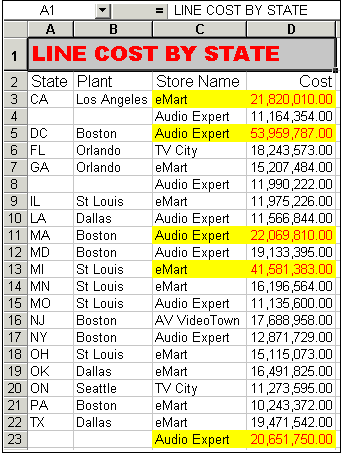
You can also adjust
column contents in your Excel spreadsheets using the StyleSheets keywords
WRAP (for wrapping column contents) and SQUEEZE (for truncating columns).
xNational Language Support With EXL2K
Excel 2000 users can select one of six languages as
their default language when generating EXL2K formatted output. In
addition to English, which is the automatic default, users can issue
a SET command to select one of five other options.
x
Syntax: How to Set the Default Language
Excel
2000 users can select one of six languages as their default language
when generating EXL2K formatted output. In addition to English,
which is the automatic default, you can select one of five other
options
SET EXL2KLANG=lang
where:
-
lang
-
Is one of the following: AME, FRE, SPA, GER, JPN or KOR.
You
can code the SET EXL2KLANG in your user profile or include it in
a FOCEXEC to override the default setting in the NLSCFG ERRORS file
for a specific request.
xDisplaying Formatted Dates and Numeric Values
When translating numeric and date formats from FOCUS
to Excel, there must be a corresponding Excel format to translate
to. If there is no corresponding format, then the value will be
formatted in the closest matching Excel format or in Excel's General format.
Excel 2000 spreadsheets generated by FOCUS contain the numeric
formatting specified in the data source Master File or as specified
in a temporary field. All FOCUS numeric values and date formats
(such as currency and Smart Dates) are translated into supported
Excel formats and display properly in Excel 2000.
Example: Displaying Formatted Numeric Data in Excel 2000
This
example illustrates how formatted numeric data appears in a spreadsheet
when you use the EXL2K format. Note that the format for the LINEPRICE
field D12.2M (that represents floating point double-precision with
two decimal places, commas, and a floating dollar sign) is translated
into the corresponding Excel format.
SET PAGE-NUM=OFF
TABLE FILE CENTORD
"Line Total Report"
"Excel 2000 Spreadsheet"
" "
SUM LINEPRICE
BY STATE AS 'State'
BY PLANTLNG AS 'Plant'
BY STORENAME AS 'Store Name'
WHERE TOTAL LINEPRICE FROM 9000000 TO 20000000
ON TABLE SET BYDISPLAY ON
ON TABLE HOLD AS EXL2K2 FORMAT EXL2K
ON TABLE SET STYLE *
TYPE=REPORT, GRID=OFF, FONT=TAHOMA, $
TYPE=HEADING, SIZE=14, COLOR=NAVY, $
TYPE=HEADING, LINE=2, SIZE=12, COLOR=RED, $
TYPE=TITLE, JUSTIFY=CENTER, STYLE=BOLD, $
TYPE=DATA, JUSTIFY=CENTER, $
TYPE=DATA, COLUMN=LINEPRICE, JUSTIFY=RIGHT, $
END
The output is:

Note the repetition
of the sort field values in the output. This presentation is particularly desirable
in a spreadsheet and is controlled by the command ON TABLE SET BYDISPLAY
ON.
Example: Displaying Formatted Dates in Excel 2000
This
example illustrates how customized dates display in a spreadsheet
when using the EXL2K format.
Month
Hired is defined in the request as MtYY format (the month is represented
as a three-character abbreviation with an initial capital letter
followed by a four-digit year).
Years of Service is defined
as I4C format, a four-digit integer with a comma if required. Both
formats are properly displayed as defined in the spreadsheet.
SET PAGE-NUM=OFF
DEFINE FILE EMPLOYEE
YRHIRED/YY = HIRE_DATE;
MHIRED/MtYY = HIRE_DATE;
TOTSVC/I4C = 2002 - YRHIRED;
END
TABLE FILE EMPLOYEE
"Employee Service Report for 2002"
"Excel 2000 Spreadsheet"
" "
PRINT FIRST_NAME AS 'First Name'
MHIRED AS 'Month Hired'
TOTSVC AS 'Years of Service'
BY LAST_NAME AS 'Last Name'
ON TABLE SET BYDISPLAY ON
ON TABLE HOLD AS EXL2K3 FORMAT EXL2K
ON TABLE SET STYLE *
TYPE=REPORT, GRID=OFF, FONT=TAHOMA, $
TYPE=HEADING, SIZE=14, COLOR=NAVY, $
TYPE=HEADING, LINE=2, SIZE=12, COLOR=RED, $
TYPE=TITLE, JUSTIFY=CENTER, STYLE=BOLD, $
TYPE=DATA, JUSTIFY=CENTER, $
TYPE=DATA, COLUMN=TOTSVC, COLOR=BLUE, WHEN=TOTSVC GT 20, $
END
The output is:
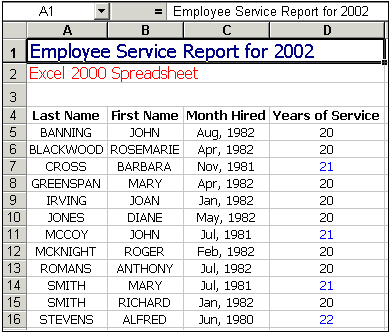
The command ON TABLE
SET BYDISPLAY ON ensures that sort fields are repeated in each spreadsheet
cell.
x
Reference: Usage Notes for Date and Numeric Formats
Warning: The
following formats are not supported in EXL2K and may produce unpredictable
results when translated into Excel's General Format:
- YY, Y, M,
D, JUL, and I2MT.
- Any date format
with a Q (quarter).
- Any packed-decimal
(P) date formats.
- Any alphanumeric
(A) date formats.
- Fixed Dollar
(N) formats.
- Multiple format
options. Only single format options are supported when using FORMAT
EXL2K. For example, the formats I9C and I9B are supported, but I9BC
is not.
The following applies
to headings and footings with embedded numeric fields:
- If you embed
a numeric field in a heading, subheading, footing, or subfooting of
a report in Excel 2000 or higher format, the numeric field displays
in Excel general format (text). To display a numeric field in Excel
number format, you must set HEADALIGN=BODY in the StyleSheet.
x
Reference: Using Date Separators in Excel
In
order to use a "-" as a separator between month, day, and year in
Excel, you must change the default date separator for Windows®.
This setting can be located under Regional Options in the Control Panel.
xControlling Column Width and Wrapping
You control data wrapping and column widths in FORMAT
EXL2K, by:
-
Turning data wrapping on. The
default behavior is to have all data wrap according to a default
column width determined by Excel.
-
Turning data wrapping off. This
setting allows columns to expand to the length of the data value.
The column width is determined by Excel, but should be wide enough
to accommodate the longest data value in the column. If a portion
of the data is hidden, you can adjust the column width in Excel
after the spreadsheet has been generated.
-
Turning data wrapping off and setting the column width at the same time. If
a data value is wider than the specified column width, a portion
of the data will be hidden from view. You can adjust the column
width in Excel after the spreadsheet has been generated.
-
Specifying the exact width of a column with data wrapping on.
x
Syntax: How to Wrap Data in Excel 2000
TYPE=REPORT, [COLUMN=column,] WRAP=value, $
where:
-
column
-
Identifies a particular column. If COLUMN is not included
in the declaration, the column width specified with SQUEEZE is applied
to the entire report.
-
value
-
Is one of the following:
-
ON
-
Turns on data wrapping. ON is the default. With this setting,
the column width is determined by the client (Excel). Data wraps
if it exceeds the width of the column and the row’s height expands
to meet the new height of the wrapped data.
- OFF
-
Turns off data wrapping. This setting adjusts the column
width of the largest data value in the column. Data will not wrap
in any cell in the column.
-
n
-
Represents a specific numeric value for the column width.
The value represents the measure specified with the UNITS parameter
(the default is inches). This is the most commonly used SQUEEZE
setting in an Excel 2000 report.
x
Syntax: How to Set Column Width in Excel 2000
TYPE=REPORT, [COLUMN=column,] SQUEEZE=n, $
where:
- column
Identifies a particular column. If COLUMN is not included
in the declaration, the column width specified with SQUEEZE is applied
to the entire report.
- n
Represents a specific numeric value for the column width.
The value represents the measure specified with the UNITS parameter
(the default is inches). This is the most commonly used SQUEEZE
setting in an Excel 2000 report.
Note: SQUEEZE=(ON/OFF),
which turns data wrapping on and off, is not supported for EXL2K,
so if a data value is wider than the specified column width, it
will be hidden from view. However, you can adjust column widths
in Excel after you generate a spreadsheet.
Example: Controlling Column Width and Wrapping in Excel 2000
The
following example illustrates how to turn on and turn off data wrapping
in a column and how to set the column width for a particular column.
The UNITS in this example are set to inches (the default).
DEFINE FILE CENTORD
MYDATE/MDY='10/22/60';
RCD/D14.3=LINE_COGS;
VERYLONG/A80='Multiply quantity times line_cost to'|
' calculate line_cost_of_goods';
END
TABLE FILE CENTORD
SUM MYDATE RCD
VERYLONG AS 'Default' VERYLONG AS 'WRAP=OFF'
VERYLONG AS 'WRAP=4.1' VERYLONG AS 'WRAP=2'
VERYLONG AS 'SQUEEZE=2' LINE_COGS
BY REGION AS 'Region'
ON TABLE HOLD AS EXL2K4 FORMAT EXL2K
ON TABLE SET STYLE *
TYPE=DATA, COLUMN=MYDATE, JUSTIFY=CENTER, $
1. TYPE=REPORT, COLUMN=VERYLONG(2), WRAP=OFF, $
2. TYPE=REPORT, COLUMN=VERYLONG(3), WRAP=4.1, $
3. TYPE=REPORT, COLUMN=VERYLONG(4), WRAP=2, $
4. TYPE=REPORT, COLUMN=VERYLONG(5), SQUEEZE=2, $
END
where:
- Identifies
the column titled "WRAP=OFF" and turns off data wrapping for that column.
- Identifies
the column titled "WRAP=4.1" and sets the column width to 4.1 inches with
data wrapping on.
- Identifies
the column titled "WRAP=2" and sets the column width to 2 inches
with data wrapping on.
- Identifies
the column titled "SQUEEZE=2" and sets the column width to 2 inches with
data wrapping off.
Note: The column titled "Default"
illustrates the default column width and wrapping behavior.
Since
the output is wider than this page, it is shown in two sections.
The following output displays the "Default", "WRAP=OFF", and "WRAP=4.1"
columns:

The following output
displays the "WRAP=2", and "SQUEEZE=2" columns:

xStyling Orientation and Borders for EXL2K Report Output
The StyleSheet options ORIENTATION=LANDSCAPE and BORDER=ON
are supported for EXL2K report output.
The BORDER attribute supports the same options as available for
FORMAT PDF except for the following border options:
-
Border line width. Excel 2003 does not have an option
for specifying a number to precisely set the border line width (thickness)
in points.
-
Borders with grooves and ridges. Excel 2003 does not
have an option for specifying grooved or ridged borders.
Note: FORMAT EXL2K does not support the GRID=ON parameter.
Example: Styling the Orientation and Border for an EXL2K Report
The following report against the EMPLOYEE
data source makes the orientation landscape and specifies dotted
red borders:
TABLE FILE EMPLOYEE
PRINT ACCTNUMBER AS 'Account Number' AND COMPUTE
LAST3_ACCT/I3L = IMOD(ACCTNUMBER, 1000, LAST3_ACCT);
BY LAST_NAME AS 'Last Name' BY FIRST_NAME AS 'First Name'
WHERE (ACCTNUMBER NE 000000000) AND (DEPARTMENT EQ 'MIS');
ON TABLE HOLD FORMAT EXL2K FORMULA
ON TABLE SET STYLE *
TYPE=REPORT, ORIENTATION=LANDSCAPE,BORDER=ON,
BORDER-COLOR=RED,BORDER-STYLE=DOTTED,$
TYPE=TITLE, SIZE=12, STYLE=BOLD, $
END
The output is:

xLocking Columns in Excel Report Output
Using StyleSheet attributes, you can lock Excel spreadsheet
values so they are read-only. These attributes apply to all Excel
formats including EXL2K, EXL2K PIVOT, and EXL2K FORMULA.
x
Syntax: How to Enable Spreadsheet Locking
To enable locking, use the following attributes:
TYPE=REPORT, PROTECTED={ON|OFF}, [LOCKED={ON|OFF}],$
where:
- TYPE=REPORT,
PROTECTED=ON
-
Is necessary to enable spreadsheet locking. PROTECTED=OFF
is the default. If you omit the LOCKED=OFF attribute, the entire
spreadsheet is locked.
- LOCKED=ON
-
Locks the entire spreadsheet. ON is the default value.
- LOCKED=OFF
-
Unlocks the spreadsheet as a whole, but enables you to lock
or unlock specific cells or groups of cells.
x
Syntax: How to Lock Specific Cells Within a Spreadsheet
Once
you include the following declaration in your StyleSheet, you can
specify the LOCKED attribute for specific cells or groups of cells:
TYPE=REPORT, PROTECTED=ON, LOCKED=OFF,$
To
lock specific parts of the spreadsheet, add the LOCKED=ON attribute
to the StyleSheet declaration for the cells you want to lock.
TYPE=type, [ COLUMN=columnspec ] ,LOCKED={ON|OFF},$where:
- type
Is the type of element that describes the cells to be locked.
- columnspec
Is a valid column specification.
Example: Locking an Entire Excel Spreadsheet
The
following request locks the entire spreadsheet because the StyleSheet declarations
include the following declaration:
TYPE=REPORT, PROTECTED=ON, $
The
request is:
TABLE FILE CAR
HEADING
"Profit By Car "
" "
SUM RETAIL_COST AND DEALER_COST AND
COMPUTE PROFIT/D12.2 = RETAIL_COST - DEALER_COST;
BY CAR
ON TABLE SET PAGE-NUM OFF
ON TABLE PCHOLD AS EXLFORM1 FORMAT EXL2K
ON TABLE SET STYLE *
TYPE=REPORT, COLOR=BLUE, BACKCOLOR=SILVER, SIZE=9,$
TYPE=REPORT, PROTECTED=ON, $
TYPE=HEADING, STYLE=BOLD, SIZE=14, $
TYPE=TITLE, STYLE=BOLD, SIZE=11,$
ENDSTYLE
END
You
cannot edit any value on the spreadsheet. Any attempt to do so displays
a message that the sheet is protected:

Example: Locking a Single Column on an Excel Spreadsheet
The
following request locks the second column (RETAIL_COST) because
the StyleSheet declarations include the following declarations
TYPE=REPORT, PROTECTED=ON, LOCKED=OFF, $
TYPE=DATA, COLUMN=2, LOCKED=ON,$
The request is:
TABLE FILE CAR
HEADING
"Profit By Car "
" "
SUM RETAIL_COST AND DEALER_COST AND
COMPUTE PROFIT/D12.2 = RETAIL_COST - DEALER_COST;
BY CAR
ON TABLE SET PAGE-NUM OFF
ON TABLE PCHOLD AS EXLFORM2 FORMAT EXL2K
ON TABLE SET STYLE *
TYPE=REPORT, COLOR=BLUE, BACKCOLOR=SILVER, SIZE=9,$
TYPE=REPORT, PROTECTED=ON, LOCKED=OFF,$
TYPE=HEADING, STYLE=BOLD, SIZE=14, $
TYPE=TITLE, STYLE=BOLD, SIZE=11,$
TYPE=DATA, COLUMN=2, LOCKED=ON,$
ENDSTYLE
END
You
cannot edit any value in column 2, although you can edit values
in other columns. Any attempt to edit a value in column 2 displays
a message that the cells are protected:
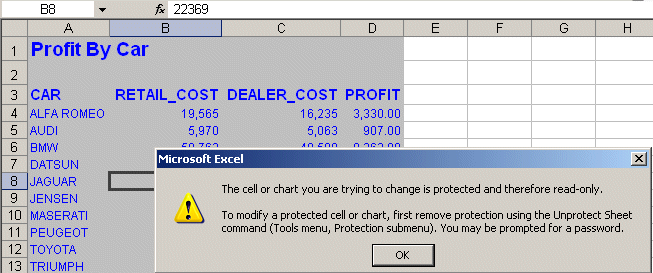
xUsing the Excel 2000 Formula Option
Since Excel users employ formulas to calculate the contents
of spreadsheet cells, the EXL2K feature includes a HOLD option for
generating correct native Excel formulas for all FOCUS summary operations,
such as row and column totals and COMPUTE commands. The EXL2K StyleSheet-related
features can also be applied with the FORMULA option.
When you display or save a tabular report request using EXL2K
FORMULA, the resulting spreadsheet contains correct native Excel
formulas that compute and display the results of all aggregation
operations (such as row totals, column totals, subtotals, and calculated values)
rather than the static values. Spreadsheets saved using the EXL2K
FORMULA format are interactive, allowing for "what if" scenarios
that immediately reflect any additions or modifications made to
the data.
The EXL2K FORMULA format is supported for the following FOCUS
TABLE options: ROWTOTAL, COLUMN-TOTAL, SUB-TOTAL, SUBTOTAL, SUMMARIZE,
RECOMPUTE, and COMPUTE, and for calculations performed by functions.
EXL2K FORMULA is not supported with PivotTables (EXL2K
PIVOT), with prefix operators, or with financial reports created
with the Financial Modeling Language (FML).
x
Syntax: How to Save a Report as FORMAT EXL2K FORMULA
Add
the following syntax to your request to include Excel formulas in
your spreadsheet:
ON TABLE HOLD FORMAT EXL2K FORMULA
Example: Generating Native Excel Formulas for Column Totals
The
following example illustrates the translation of a column total
in a report request into an Excel formula when using format EXL2K
FORMULA. Note that the formatting of the column total (TYPE=GRANDTOTAL)
is retained in the Excel 2000 spreadsheet.
When
you select the total in the report, the equation =SUM(B4:B7) appears
in the formula bar, representing the column total as a sum of cell
ranges.
TABLE FILE CENTORD
HEADING
"Projected Return By Region"
" "
SUM LINE_COGS AS 'RETURN'
BY REGION AS 'REGION'
ON TABLE COLUMN-TOTAL
ON TABLE HOLD AS EXL2K5 FORMAT EXL2K FORMULA
ON TABLE SET STYLE *
TYPE=REPORT, COLOR=BLUE, BACKCOLOR=SILVER, SIZE=9,$
TYPE=HEADING, STYLE=BOLD, SIZE=14,$
TYPE=TITLE, STYLE=BOLD+UNDERLINE, SIZE=10,$
TYPE=GRANDTOTAL, STYLE=BOLD,$
ENDSTYLE
END
The output is:

Example: Generating Native Excel Formulas for Row Totals
This
request calculates totals for line price and quantity across regions.
The row totals are represented as sums of cell ranges.
TABLE FILE CENTORD
HEADING
"Projected Line Cost Across Region"
" "
SUM LINEPRICE AND QUANTITY
ACROSS REGION AS 'Region'
BY STORENAME
WHERE REGION EQ 'EAST' OR 'NORTH'
ON REGION ROW-TOTAL AS 'TOTAL'
ON TABLE COLUMN-TOTAL AS 'TOTAL'
ON TABLE HOLD AS EXL2K6 FORMAT EXL2K FORMULA
ON TABLE SET STYLE *
TYPE=REPORT, COLOR=BLUE, BACKCOLOR=SILVER, SIZE=9,$
TYPE=HEADING, STYLE=BOLD, SIZE=14,$
TYPE=TITLE, STYLE=BOLD, SIZE=11,$
TYPE=SUBTOTAL, STYLE=BOLD, $
TYPE=GRANDTOTAL, STYLE=BOLD, SIZE=11,$
TYPE=ACROSSTITLE, STYLE=BOLD, SIZE=11, JUSTIFY=LEFT,$
TYPE=ACROSSVALUE, STYLE=BOLD, SIZE=10, JUSTIFY=CENTER,$
ENDSTYLE
END
The output highlights the formula that calculates
the row total in cell G11=C11+E11:

Example: Generating Native Excel Formulas for Calculated Values
This
request totals the columns for line price and quantity and calculates
the value of a field called LINECOST by multiplying the line price
by the quantity.
The
formula for the calculated values is generated by translating the
internal form of the FOCUS expression (COMPUTE LINECOST/P24.2MC=QUANTITY*LINEPRICE;)
into an Excel formula.
TABLE FILE CENTORD
ON TABLE SET PAGE-NUM OFF
SUM LINEPRICE AND QUANTITY AS 'Quantity'
COMPUTE LINECOST/P24.2MC = QUANTITY * LINEPRICE; AS 'Total Cost'
BY REGION AS 'Region'
HEADING
"Line Cost of Goods by Region"
" "
ON TABLE COLUMN-TOTAL
ON TABLE HOLD AS EXL2K7 FORMAT EXL2K FORMULA
ON TABLE SET STYLE *
TYPE=REPORT, COLOR=BLUE, BACKCOLOR=SILVER, SIZE=9,$
TYPE=HEADING, STYLE=BOLD, SIZE=14,$
TYPE=TITLE, STYLE=BOLD, SIZE=11,$
TYPE=GRANDTOTAL, STYLE=BOLD, SIZE=11,$
ENDSTYLE
END
The top line in the spreadsheet output highlights
the formula.

Example: Generating Native Excel Formulas for Functions
The
following illustrates how functions are translated to Excel 2000
reports. The function IMOD divides ACCTNUMBER by 1000 and returns
the remainder to LAST3_ACCT. The Excel formula corresponds to this,
=(MOD($C2,1000)).
TABLE FILE EMPLOYEE
PRINT ACCTNUMBER AS 'Account Number' AND COMPUTE
LAST3_ACCT/I3L = IMOD(ACCTNUMBER, 1000, LAST3_ACCT);
BY LAST_NAME AS 'Last Name' BY FIRST_NAME AS 'First Name'
WHERE (ACCTNUMBER NE 000000000) AND (DEPARTMENT EQ 'MIS')
ON TABLE HOLD AS EXL2K8 FORMAT EXL2K FORMULA
ON TABLE SET STYLE *
TYPE=TITLE, SIZE = 12, STYLE=BOLD,$
END
The output is:

x
Reference: Translation Support for FORMAT EXL2K FORMULA
- All standard
operators are supported. These include arithmetic operators, relational
operators, string operators, IF/THEN/ELSE, and logical operators.
- The IS-MISSING
operator is not supported.
- The following
functions are supported: ABS, ARGLEN, ATODBL, BYTVAL, CHARGET, CTRAN,
CTRFLD, DECODE DMOD, DOWK, DOWKI, DOWKL, DOWKLI, EDIT (1 argument variant
only), EXP, EXPN, FMOD, HEXBYT, HHMMSS, IMOD, INT, LCWORD, LJUST, LOCASE,
LOG, MAX, MIN, OVRLAY, POSIT, RDUNIF, RANDOM, RJUST, SQRT, SUBSTR, TODAY,
TODAYI, UPCASE, YM.
- If you use
the COMPUTE command with an unsupported function, an error message appears.
- EXL2K FORMULA
is not supported with the following FOCUS commands and phrases:
- DEFINE.
- OVER.
- NOPRINT. If
your report contains a calculated value (generated by the COMPUTE
command), all of the fields referenced by the calculated value must
be displayed in the report.
- Multiple display
(PRINT, LIST, SUM, and COUNT) commands.
- SEQUENCE.
- RECAP.
- Prefix operators.
- Formulas for
ROW-TOTALs and COLUMN-TOTALs are represented as sums of cell ranges.
For example, =SUM(G2:G10).
- A formula
for a calculated value is generated by translating the internal
form of the FOCUS expression into an Excel formula.
- Excel formulas
are limited to 1024 characters. Therefore, the translation to an Excel
formula will fail if a FOCUS total or the result of an expression
requires more than 1024 bytes of Excel formula code. An error message
will be generated.
- Conditional
styling is based on the values in the original report. If the spreadsheet values
are changed and the formulas are recomputed, the styling will not
reflect the updated information.
xUsing the Excel 2000 PIVOT Option
The power of EXL2K format derives in large measure from
its ability to take advantage of PivotTables. PivotTables are Microsoft
Excel tools for analyzing complex data. They allow you to drag and
drop data fields within a PivotTable spreadsheet, providing different
views of the data, such as sorting across rows or columns. You can
also create dimensional hierarchies by using the PAGEFIELDS option.
When you use FORMAT EXL2K PIVOT, two data streams are created:
- The first
data stream is the PivotTable file containing the actual spreadsheet data.
The PivotTable file (.xht) is an HTML file with embedded XML. The
HTML file contains all the information that will be displayed in
your browser.
- The second
data stream is the PivotTable cache file (.xml). The PivotTable
cache file is a metadata type file. It contains all the fields specified
in the procedure and links internally to the PivotTable file. The
PivotTable cache file can contain data fields called CACHEFIELDS,
which populate the PivotTable toolbar, but do not initially display
in the report. CACHEFIELDS can be dragged and dropped from the PivotTable
toolbar into the PivotTable when required for analysis.
After creating FOCUS reports formatted as Excel PivotTables you
must transfer both the XHT and XML files to Excel 2000 using FTP
in ASCII mode or another transfer facility.
x
Syntax: How to Generate a PivotTable
ON TABLE HOLD FORMAT EXL2K PIVOT AS mypivot
where:
-
mypivot
-
Is a name you assign to the HOLD file.
Two
files are generated with this syntax:
- MYPIVOT.XHT
is the main PivotTable spreadsheet file that will be displayed in the
browser or Excel window.
- MYPIVOT$.XML
is the Pivot Cache file.
Standard
HOLD and SAVE syntax is supported for EXL2K PIVOT. The PivotTable
cache file contains all the fields specified in the procedure and
links internally to the PivotTable file. All available fields can
be viewed in the PivotTable toolbar.
x
Reference: Usage Notes for PivotTable Requests
Keep
these considerations in mind when preparing output for a PivotTable:
- Requests must
include the display command PRINT. This is necessary to extract
all data (each individual record) into the pivot cache file. The
field following the PRINT command is designated the PivotTable Data
field and must be numeric. Note that the SUM and COUNT commands
are not supported for EXL2K PIVOT. Nevertheless, you can
use this native PivotTable behavior in Excel once the data has been
output to an Excel PivotTable.
- Fields used
in a PivotTable cannot appear more than once in the report request. Each
field can function in only one role in a FORMAT EXL2K PIVOT request.
For example, a Page field cannot appear simultaneously as a column
and a row field.
- Styling is
based on the initial state of your report and is retained only on
a limited basis when you pivot the output.
- NODATA fields
appear as blank cells in the PivotTable.
- You can include
column, row, grand totals, and subtotals in a PivotTable. If no totals
are specified in a request, no totals will display in Excel 2000.
Example: Using the EXL2K PIVOT Option
This
simple example shows how to populate and generate PivotTables:
TABLE FILE CENTINV
HEADING
"CENTINV File PivotTable"
"Sum of Price by Product Across Category"
PRINT PRICE
BY PROD_NUM
ACROSS PRODCAT
ON TABLE COLUMN-TOTAL
ON TABLE HOLD AS EXL2K9 FORMAT EXL2K PIVOT
PAGEFIELDS PRODNAME
CACHEFIELDS COST QTY_IN_STOCK
ON TABLE SET STYLE *
TYPE=HEADING, LINE=1, FONT='ARIAL', COLOR=PURPLE, SIZE=16, STYLE=BOLD,$
TYPE=HEADING, LINE=2, FONT='ARIAL', COLOR=PURPLE, SIZE=12, STYLE=BOLD,$
TYPE=DATA, FONT='ARIAL', COLOR=PURPLE,$
TYPE=GRANDTOTAL, FONT='ARIAL', COLOR=PURPLE, SIZE=12, STYLE=BOLD,$
ENDSTYLE
END
The output is:

x
Reference: How TABLE Elements Appear in a Pivot Table
The
PivotTable is generated by the PRINT command in combination with
the BY, ACROSS, PAGEFIELDS, and CACHEFIELDS phrases. It contains
all options used to design and format the report, as well as fields
specified in the PIVOT request. Fields can be dragged into the report
from the toolbar. The following graphic and summary table depicts
PivotTable output with major elements and associated FOCUS syntax.
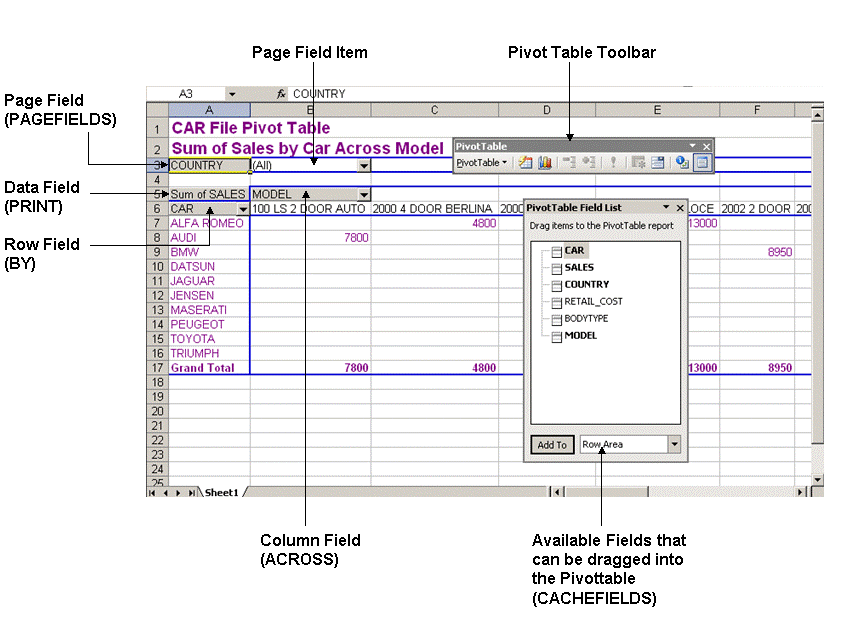
x
Reference: Effects of TABLE Syntax on PivotTable Requests
This
table summarizes the effects of TABLE request syntax elements within
EXL2K PIVOT operations. You must include at least one sort field
or a PAGEFIELD to have a valid Pivot Table request.
|
Syntax Element
|
Usage
|
Effect on PivotTable
|
|---|
|
PRINT
|
Required
|
Designates the data field in a PivotTable.
|
|
BY
|
Optional
|
Designates row field in a PivotTable.
|
|
ACROSS
|
Optional
|
Designates a column field in a PivotTable.
|
|
CACHEFIELDS
|
Optional
|
Places fields in the Pivot cache file and
makes them available from the Pivot toolbar.
|
|
PAGEFIELDS
|
Optional
|
Designates a Page field in a PivotTable.
|
x
Reference: Content, Function and Origin of PivotTable Elements
|
PivotTable Element
|
Contains...
|
Function
|
Generating Syntax
|
|---|
|
Page field
|
Field that controls view of the entire page (worksheet).
|
A filtering mechanism to conduct a high
level sort.
|
PAGEFIELDS phrase
|
|
Page field item
|
The value for a page field item appears in
a drop-down list.
|
Selecting a page field item summarizes data
for the entire report.
|
PAGEFIELDS phrase
|
|
Data field
|
Numeric data that is available to be summarized
|
Holds data available to be summarized
|
PRINT command
|
|
Column field
|
Horizontal sort data
|
Sorts data horizontally.
|
ACROSS command
|
|
Row field
|
Vertical sort data
|
Sorts data vertically.
|
BY command
|
xDesignating CACHEFIELDS in PivotTables
By including a CACHEFIELDS phrase in your EXL2K request,
you can add fields to the pivot cache not initially displayed in
the report. The cache file enables you to add available fields from
the PivotTable toolbar into the body of the PivotTable by dragging and
dropping. You can also remove fields from the PivotTable by dragging
and dropping them outside the report. In either case, you can very
quickly vary your data views.
The CACHEFIELDS phrase is optional; you can always generate a
PivotTable without one.
x
Reference: Usage Notes for Specifying CACHEFIELDS
Fields
designated as CACHEFIELDS must immediately follow the PIVOT keyword
in the ON TABLE HOLD FORMAT EXL2K PIVOT syntax or follow a PAGEFIELDS phrase.
A CACHEFIELD cannot be designated elsewhere in the request. Lists
of CACHEFIELDS are terminated by the same keywords that terminate
normal report requests, such as END or another ON phrase.
Example: Using CACHEFIELDS With EXL2K PIVOT
This
example shows how to specify CACHEFIELDS to populate the PivotTable toolbar.
TABLE FILE CENTINV
HEADING
"PivotTable with CACHEFIELDS"
"Sum of Price by Product Across Category"
PRINT PRICE
BY PRODCAT BY PRODTYPE
ON PRODCAT SUB-TOTAL
ON TABLE HOLD AS EXL2K10 FORMAT EXL2K PIVOT
CACHEFIELDS COST PRODNAME
ON TABLE SET STYLE *
TYPE=DATA, COLUMN=PRODCAT, COLOR=RED,$
TYPE=HEADING, COLOR=BLUE, STYLE=BOLD, SIZE=14,$
ENDSTYLE
END
The output is:
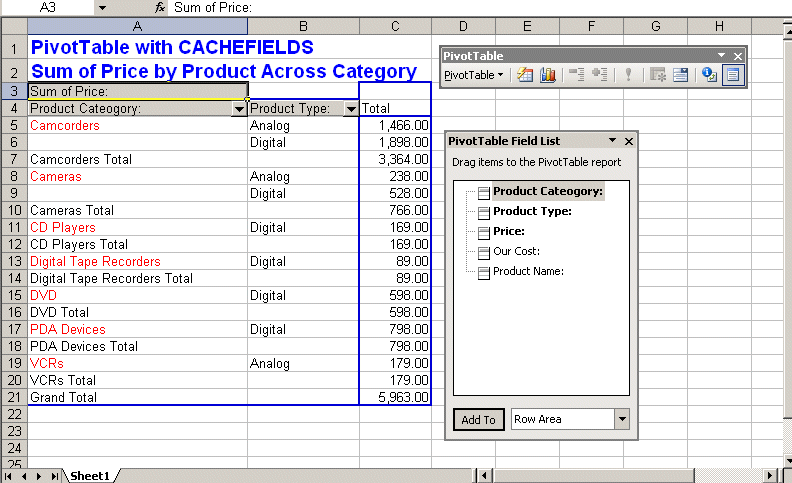
xDesignating PAGEFIELDS in PivotTables
You can specify fields in the procedure as Excel 2000
page fields. Page fields filter the data for the field value specified.
Through PivotTable functionality, you can select a single value
from the page field drop-down menu (also called a page field item)
to display only data associated with that selection. For example,
in a report showing international car sales data, if you specify
COUNTRY as your page field and JAPAN as the page field item, you
will display only sales data for Japanese cars. If you then select ENGLAND,
you will see the data for JAGUAR and TRIUMPH.
A page field can act as the sort field. Valid PivotTables can
be generated without specifying a PAGEFIELD if sorting is handled
by either a BY or ACROSS phrase. However, if the request contains
neither a BY or ACROSS phrase, a PAGEFIELD must be included.
Note:
- A field
specified as a PAGEFIELD cannot be designated anywhere else in the request.
- Because Excel
is case insensitive, the values of the PAGEFIELD must not contain duplicate
values in different cases. For example, "JONES" and "jones" are
considered equal in Excel. Use the UPCASE and LOCASE functions to
convert mixed-case values.
Example: Using FORMAT EXL2K PIVOT With PAGEFIELDS
This
example illustrates the use of PAGEFIELDS syntax to make three fields
available in the PivotTable toolbar.
TABLE FILE CENTINV
HEADING
"PivotTable with PAGEFIELDS"
PRINT PRICE COST
ON TABLE HOLD AS EXL2K11 FORMAT EXL2K PIVOT
PAGEFIELDS PRODCAT PRODNAME PRODTYPE
ON TABLE SET STYLE *
TYPE=DATA, COLUMN=PRODCAT, COLOR=RED,$
TYPE=HEADING, COLOR=BLUE, STYLE=BOLD, SIZE=14,$
ENDSTYLE
END
This output is:

x
An Excel Named Range is a name assigned to a specific
group of cells within an Excel worksheet that can be easily referenced
by FOCUS applications. The FOCUS StyleSheet language facilitates
the generation of Named Ranges.
The use of Excel Named Ranges provides many benefits, including
the following:
- Provides
advantages over static cell references, including the ability of
named range data areas to expand to include new data added during
scheduled workbook updates.
- Enables easy
setup of Excel worksheets, created by FOCUS applications, as an ODBC
(Open Database Connectivity) data source.
- Provides accurate,
consistent data feeds to advanced Excel worksheet applications,
which eliminates manual activities that tend to result in errors.
- Simplifies
the process of referencing data in multiple worksheets.
x
Syntax: How to Use Excel Named Ranges
To
create Excel Named Ranges, use
TYPE=type, IN-RANGES=rangename, $
where:
-
type
-
Identifies the FOCUS report component to be included in the
range. Normally, both of the following are used together:
DATA adds
the DATA element of the report to the named range (excludes heading,
footing, and column titles).
TITLE adds the
TITLE element of the report to the named range (includes all column
titles).
Note: Multiple elements can be added to the
same named range.
-
rangename
-
Is the name assigned to the output in the Excel workbook
your application is creating, and is also the name that will be
referenced by other FOCUS applications.
Example: Using Excel Named Ranges
This
example creates one report in one worksheet of an Excel workbook.
The code specific to Excel Named Ranges appears in bold in the following
syntax.
TABLE FILE GGSALES
PRINT
PRODUCT
DATE
UNITS
BY REGION
BY DOLLARS
ON TABLE SET PAGE-NUM OFF
ON TABLE SET BYDISPLAY ON
ON TABLE NOTOTAL
ON TABLE HOLD FORMAT EXL2K
ON TABLE SET STYLE *
UNITS=IN, SQUEEZE=ON, ORIENTATION=PORTRAIT, $
TYPE=REPORT, FONT='ARIAL', SIZE=9, COLOR='BLACK', BACKCOLOR='NONE',
STYLE=NORMAL, $
TYPE=DATA, IN-RANGES='RegionalSales', $
TYPE=TITLE, STYLE=BOLD, IN-RANGES='RegionalSales', $
ENDSTYLE
ENDThe Excel output is:
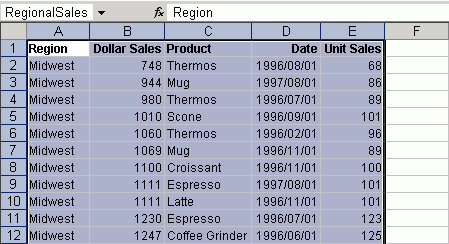
The name assigned
to this Excel Named Range is RegionalSales. If additional rows of data
are added, or columns of data are inserted, the named range will
stretch to contain both new and existing data.
x
Reference: Rules for Excel Named Ranges
- The Excel
data area associated with a named range must be continuous and cannot
contain any breaks in the data. Examples of report components containing
breaks in the data that cannot be part of a named range include SUBHEAD
and SUBFOOT.
- It is recommended
that you use ON TABLE SET BYDISPLAY ON. This activates the option
to display repeated sort values, which produces continuous output
with no breaks in the data.
- Two different
worksheets from the same workbook cannot have the same range name.
- When creating
Compound Excel reports (multiple TABLE requests output to the same
Excel workbook), each report must have a unique range name that
is stored at the workbook level.
x
Reference: Support for Excel Named Ranges
Excel
Named Ranges are supported for the following Excel formats:
EXL2K, EXL2K FORMULA
Excel
Named Ranges are not supported for the following Excel formats:
EXL2K BYTOC, EXCEL PIVOT
Excel
Named Ranges are not supported with any report syntax that produces discontinuous
data or uses columnar references that span multiple columns, which
includes the following:
ACROSSCOLUMN, RECAP, RECOMPUTE, SUBHEAD, SUBFOOT, SUBTOTAL, SUB-TOTAL
xIdentifying Null Values in Excel 2000
When a report is formatted as EXL2K, and null values
are retrieved for one or more fields, blank spaces are displayed
by default in each cell of the report output for the empty (null)
fields. This behavior is the result of SET EMPTYCELLS ON being set
by default in the background of all EXL2K reports. If you want to
identify null values with something other than blank spaces, a character
string can be used to populate all empty fields in a report.
x
Syntax: How to Identify Null Values in EXL2K Report Output
Outside
of a report request, use the following syntax
SET NODATA = character_string
SET EMPTYCELLS = [ON|OFF]
In
a report request, use the following syntax
ON TABLE SET NODATA character_string
ON TABLE SET EMPTYCELLS [ON|OFF]
where:
- character_string
Is the string of characters displayed in the cells of the
report for each field where null values are retrieved from the database.
The maximum number of characters is 11. If the number of characters
in the string exceeds the length of the output field, the additional
characters will not be displayed. If special characters are used,
the string must be enclosed in single quotes. SET EMPTYCELLS OFF
must also be specified to make the SET NODATA command effective.
- ON
Indicates that empty spaces are displayed in the cells of
the report for each field where null values are retrieved from the
database. ON is the default.
- OFF
Indicates that zeros, or the character string specified with
the SET NODATA command, will be displayed in the cells of the report
for each field where null values are retrieved from the database.
OFF must be specified when using SET NODATA.
Example: Identifying Null Values in EXL2K Report Output
The
following syntax utilizes the default behavior of ON TABLE SET EMPTYCELLS
ON, which is set in the background:
TABLE FILE CAR
SUM SALES BY COUNTRY ACROSS SEATS
ON TABLE HOLD FORMAT EXL2K
ON TABLE SET STYLE *
TYPE = ACROSSTITLE, STYLE=BOLD,$TYPE = TITLE, STYLE = BOLD,$
ENDSTYLE
END
The following output displays empty spaces in
the cells of the report for each field where null values are retrieved
from the database:

The following syntax
utilizes the SET NODATA command:
TABLE FILE CAR
SUM SALES BY COUNTRY ACROSS SEATS
ON TABLE SET NODATA 'n/a'
ON TABLE SET EMPTYCELLS OFF
ON TABLE HOLD FORMAT EXL2K
ON TABLE SET STYLE *
TYPE = ACROSSTITLE, STYLE=BOLD,$TYPE = TITLE, STYLE = BOLD,$
ENDSTYLE
END
Note: If you do not add SET EMPTYCELLS
OFF, the SET NODATA command will be ignored.
The following
output displays 'n/a' in the cells of the report for each field
where null values are retrieved from the database:

The following syntax
turns off the default SET EMPTYCELLS behavior and does not use SET
NODATA, which makes it impossible to distinguish null values from
zero quantities:
TABLE FILE CAR
SUM SALES BY COUNTRY ACROSS SEATS
ON TABLE SET EMPTYCELLS OFF
ON TABLE HOLD FORMAT EXL2K
ON TABLE SET STYLE *
TYPE = ACROSSTITLE, STYLE=BOLD,$TYPE = TITLE, STYLE = BOLD,$
ENDSTYLE
END
The following output displays zeros in the cells
of the report for each field where either null values are retrieved
from the database or the quantity is zero:

x
Excel Table of Contents (TOC) is a feature that enables
you to generate a multiple worksheet report in which a separate
worksheet is generated for each value of the first BY field in the
FOCUS report.
Note: This feature can be used only with Excel 2002 or
higher releases because it requires the Web Archive file format,
which was not available in Excel 2000 and earlier releases.
x
Syntax: How to Use the Excel Table of Contents Feature
Only
a single BY field is allowed in an EXL2K Table of Contents report.
ON
TABLE HOLD FORMAT EXL2K BYTOC
Since only one level
of TOC is allowed for EXL2K reports, the optional number following the
BYTOC keyword can only be 1.
The SET COMPOUND syntax, which
precedes the TABLE command, may also be used to specify that a TOC
be created:
SET COMPOUND=BYTOC
Since
a TOC report is burst into worksheets according to the value of
the first BY field in the report, the report must contain at least
one BY field. The bursting field may be a NOPRINT field.
x
Reference: How to Name Worksheets
- The worksheet
tab names are the BY field values that correspond to the data on
the current worksheet. If the user specifies the TITLETEXT keyword
in the stylesheet, it will be ignored.
- Excel limits
the length of worksheet titles to 31 characters. The following special characters
cannot be used: ':', '?', '*', and '/'.
x
Reference: Limitations of TOC Reports
- A TOC report
cannot be embedded in a compound report.
- A TOC report
cannot be a pivot table report.
Example: Creating a Simple TOC Report
SET COMPOUND=BYTOC
TABLE FILE CAR
PRINT SALES BY COUNTRY NOPRINT BY CAR
ON TABLE HOLD FORMAT EXL2K
ON TABLE SET STYLE *
type=report, style=bold, color=yellow, backcolor=black, $
type=data, backcolor=red, $type=data, column=car, color=blue, backcolor=yellow, $
END
The output is:

x
Excel Compound Reports is a feature which enables you
to generate multiple worksheet reports using the EXL2K output format.
The syntax of this feature is identical to that of PDF Compound
Reports. By default, each of the component reports from the compound
report is placed in a new Excel worksheet (analogous to a new page
in PDF). If the NOBREAK keyword is used, the next report follows the
current report on the same worksheet (analogous to starting the
report on the same page in PDF).
Output is generated in Microsoft's Web Archive format. This format
is labeled Single File Web Page in Excel's Save As dialog. Excel
provides the conventionally given file types: MHT or MHTML. FOCUS
uses the same XHT file type that is used for EXL2K reports.
The components of an Excel compound report can be FORMULA or
PIVOT reports (subject to the restrictions). They cannot be Table
of Contents (TOC) reports.
Note: Excel 2002 (Office XP) or higher must be installed.
This feature will not work with earlier versions of Excel since
they do not support the Web Archive file format.
x
Reference: Guidelines for Using the OPEN, CLOSE, and NOBREAK Keywords and SET COMPOUND
As
with PDF, the keywords OPEN, CLOSE, and NOBREAK are used to control
Excel compound reports. They can be specified with the HOLD command
or with a separate SET COMPOUND command.
- OPEN is used
on the first report of a sequence of component reports to specify
that a compound report be produced.
- CLOSE is used
to designate the last report in a compound report.
- NOBREAK specifies
that the next report be placed on the same worksheet as the current
report. If it is not present, the default behavior is to place the
next report on a separate worksheet.
NOBREAK may appear with
OPEN on the first report, or alone on a report between the first
and last reports. (Using CLOSE is irrelevant, since it refers to
the placement of the next report, and no report follows the final
report on which CLOSE appears.)
- When used
with the HOLD syntax, the compound report keywords OPEN, CLOSE, and
NOBREAK must appear immediately after FORMAT EXL2K, and before any additional
keywords, such as FORMULA or PIVOT. For example, you can specify:
-
ON
TABLE HOLD FORMAT EXL2K OPEN
-
ON
TABLE HOLD AS MYHOLD FORMAT EXL2K OPEN NOBREAK
-
ON
TABLE HOLD FORMAT EXL2K NOBREAK FORMULA
-
ON
TABLE HOLD FORMAT EXL2K CLOSE PIVOT PAGEFIELDS COUNTRY
- As with PDF
compound reports, compound report keywords can be alternatively specified
using SET COMPOUND:
-
SET
COMPOUND = OPEN
-
SET
COMPOUND = 'OPEN NOBREAK'
-
SET
COMPOUND = NOBREAK
-
SET
COMPOUND = CLOSE
x
Reference: Guidelines for Producing Excel Compound Reports
-
Pivot Tables and NOBREAK. Pivot
Table Reports may appear in compound reports, but they may not be
combined with another report on the same worksheet using NOBREAK.
-
Naming of Worksheets. The
default worksheet tab names will be Sheet1, Sheet2, and so on. You
have the option to specify a different worksheet tab name by using
the TITLETEXT keyword in the stylesheet. For example:
TYPE=REPORT, TITLETEXT='Summary Report', $
Excel
limits the length of worksheet titles to 31 characters. The following
special characters cannot be used: ':', '?', '*', and '/'.
-
NOBREAK Behavior. When
NOBREAK is specified, the following report appears on the row immediately
after the last row of the report with the NOBREAK. If additional
spacing is required between the reports, a FOOTING or an ON TABLE
SUBFOOT can be placed on the report with the NOBREAK, or a HEADING
or an ON TABLE SUBHEAD can be placed on the following report. This
allows the most flexibility, since if blank rows were added by default
there would be no way to remove them.
Example: Creating a Simple Compound Report Using EXL2K
SET PAGE-NUM=OFF
TABLE FILE CAR
HEADING
"Sales Report"
" "
SUM SALES
BY COUNTRY
ON TABLE SET STYLE *
type=report, titletext='Sales Rpt', $
type=heading, size=18, $
ENDSTYLE
ON TABLE HOLD AS EX1 FORMAT EXL2K OPEN
END
TABLE FILE CAR
HEADING
"Inventory Report"
" "
SUM RC
BY COUNTRY
ON TABLE SET STYLE *
type=report, titletext='Inv. Rpt', $
type=heading, size=18, $
ENDSTYLE
ON TABLE HOLD FORMAT EXL2K
END
TABLE FILE CAR
HEADING
"Cost of Goods Sold Report"
" "
SUM DC
BY COUNTRY
ON TABLE SET STYLE *
type=report, titletext='Cost Rpt', $
type=heading, size=18, $
ENDSTYLE
ON TABLE HOLD FORMAT EXL2K CLOSE
END
The output for each tab in the Excel worksheet
is:
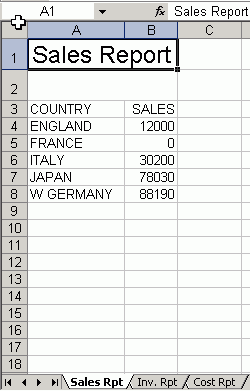
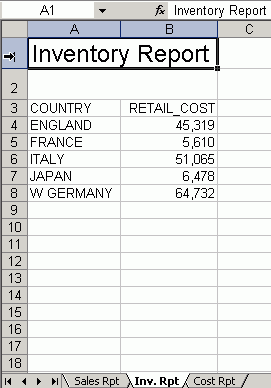

Example: Creating a Compound Report With Pivot Tables and Formulas
SET PAGE-NUM=OFF
TABLE FILE CAR
HEADING
"Sales Report"
" "
PRINT RCOST
BY COUNTRY
ON TABLE SET STYLE *
type=report, titletext='Sales Rpt', $
type=heading, size=18, $
ENDSTYLE
ON TABLE HOLD AS PIV1 FORMAT EXL2K OPEN
END
TABLE FILE CAR
HEADING
"Inventory Report"
" "
PRINT SALES
BY COUNTRY
ON TABLE SET STYLE *
type=report, titletext='Inv. Rpt', $
type=heading, size=18, $
ENDSTYLE
ON TABLE HOLD AS PPPP FORMAT EXL2K PIVOT
PAGEFIELDS TYPE SEATS
CACHEFIELDS MODEL MPG RPM
END
TABLE FILE CAR
SUM RCOST
BY COUNTRY BY CAR BY MODEL BY TYPE BY SEATS SUMMARIZE
ON MODEL SUB-TOTAL
ON TABLE HOLD AS XFOCB FORMAT EXL2K FORMULA
END
TABLE FILE CAR
HEADING
"Cost of Goods Sold Report"
" "
PRINT DCOST
BY COUNTRY
ON TABLE SET STYLE *
type=report, titletext='Cost Rpt', $
type=heading, size=18, $
ENDSTYLE
ON TABLE HOLD AS ONE FORMAT EXL2K CLOSE PIVOT
PAGEFIELDS RCOST
CACHEFIELDS MODEL TYPE SALES ACCEL SEATS
END
The output for each tab in the Excel worksheet
is:
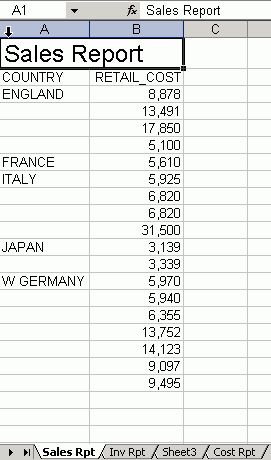

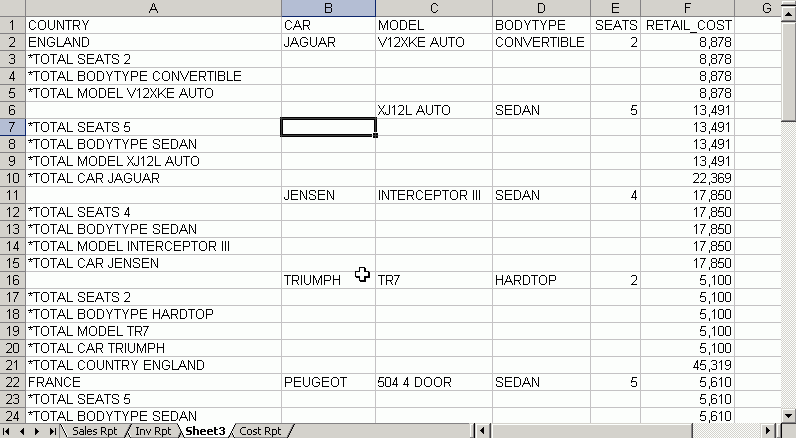

Example: Creating a Compound Report Using NOBREAK
In this example, the first two reports
are on the first worksheet, and the last two reports are on the
second worksheet, since NOBREAK appears on both the first and third reports.
TABLE FILE CAR
HEADING
"Report 1: England"
PRINT DCOST BY COUNTRY BY CAR
IF COUNTRY EQ ENGLAND
ON TABLE HOLD FORMAT EXL2K OPEN NOBREAK
ON TABLE SET STYLE *
type=report, color=red, $
type=data, backcolor=yellow, $
type=heading, color=blue, $
END
TABLE FILE CAR
HEADING
" "
" "
"Report 2: France"
PRINT RCOST BY COUNTRY
IF COUNTRY EQ FRANCE
ACROSS SEATS
ON TABLE HOLD FORMAT EXL2K
ON TABLE SET STYLE *
type=report, color=lime, backcolor=fuschia, style=bold, $
type=title, color=black, style=bold+italic, $
type=heading, backcolor=black, $
END
TABLE FILE CAR
FOOTING
"Report 3 - All"
PRINT SALES BY COUNTRY BY CAR
ON TABLE HOLD FORMAT EXL2K NOBREAK
ON TABLE SET STYLE *
type=report, backcolor=yellow, style=bold, $
type=title, color=blue, $
type=footing, backcolor=aqua, $
END
TABLE FILE CAR
HEADING
" "
" "
"Report 4"
PRINT SALES BY COUNTRY BY CAR
ON TABLE HOLD FORMAT EXL2K CLOSE
ON TABLE SET STYLE *
type=report, color=yellow, backcolor=black, style=bold, $
END
The output is:
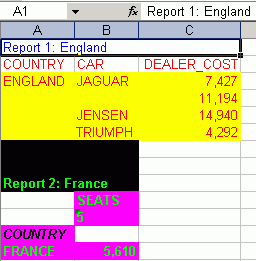

xTransferring Excel 2000 Formatted Files Using FTP
After creating an Excel 2000 formatted file, you must
transfer it from the mainframe to your PC to view and use it. The
following illustrates the process of using FTP in Microsoft Windows
to retrieve the files from the mainframe:
C:\temp\work>ftp ibimvs
Connected to ibimvs.ibi.com.
220-FTPD1 IBM FTP CS V2R10 at IBIMVS.IBI.COM, 15:24:50 on 2003-11-06.
220 Connection will close if idle for more than 5 minutes.
User (ibimvs.ibi.com:(none)): userid1
331 Send password please.
Password:
230 USERID1 is logged on. Working directory is "USERID1.".
ftp> get pivotmvs.xht pivot.xht
200 Port request OK.
125 Sending data set USERID1.PIVOTMVS.XHT
250 Transfer completed successfully.
ftp: 8387 bytes received in 0.14Seconds 59.48Kbytes/sec.
ftp> get pivotmvs.xml pivot.xml
200 Port request OK.
125 Sending data set USERID1.PIVOTMVS.XML
250 Transfer completed successfully.
ftp: 1940 bytes received in 0.16Seconds 12.44Kbytes/sec.
ftp> by
221 Quit command received. Goodbye.
x
Reference: Important Considerations for Transferring EXL2K-generated Files
- You must transfer
the file as an ASCII file.
- Whatever name
you give the file ("HOLD" or an "asname" assigned with a HOLD AS
phrase) must be kept for the transferred file. The HOLD EXL2K PIVOT
operation actually produces two files; an "asname.XHT" data file
and an "asname$.XML" PivotTable file.
- Before the
FTP operation on z/OS, issue a DYNAM FREE for both the "asname"
and the "asname$" ddnames.
xCreating Styled Excel 97 Files
EXL97 is an HTML-based HOLD format for generating formatted
Excel 97 spreadsheets. EXL97 is a full StyleSheet driver for accurately
rendering all report elements (such as headings and subtotals, for
example) as well as applying StyleSheet syntax (such as conditional
styling). You must have Microsoft Excel 97 or higher installed on
your computer to display an Excel 97 report.
While Excel 97 is fully compatible with Excel 2000 and Excel
2002, we strongly recommend upgrading to Excel 2000 to exploit its
broader range of features and future Excel enhancements, which will
primarily be made to the EXL2K format. See Limitations for FORMAT EXL97.
x
Syntax: How to Create a Styled Excel 97 File
To
produce an Excel 97 spreadsheet, create a FOCUS report using the
Excel 97 HOLD option and then transfer the output file to your browser
and open it in Excel 97. The HOLD syntax is
[ON TABLE] HOLD [AS filename] FORMAT EXL97
where:
- EXL97
-
Creates an Excel-formatted HTML file, with an extension of
.HTM, which may include styling based on FOCUS StyleSheet features.
The MIME type assigned automatically designates Excel as the active
application for this file type. Before you can see or work with
this file you must transfer it to your PC.
Example: Creating an EXL97 Output File
The
following example shows how to create a report in EXL97 format based
on the contents of CENTORD, with conditional styling:
TABLE FILE CENTORD
HEADING
"Order Revenue"
"Styled Report in Excel 97"
" "
SUM ORDER_DATE LINEPRICE AS 'Order,Total:'
BY HIGHEST 10 ORDER_NUM
ON TABLE SET PAGE-NUM OFF
ON TABLE HOLD FORMAT EXL97
ON TABLE SET STYLE *
TYPE=HEADING, COLOR=NAVY, SIZE=10, $
TYPE=HEADING, LINE=2, COLOR=RED, $
TYPE=DATA, BACKCOLOR=AQUA, STYLE=BOLD, WHEN=LINEPRICE GT 200000, $
TYPE=TITLE, STYLE=BOLD, $
END
The output is:
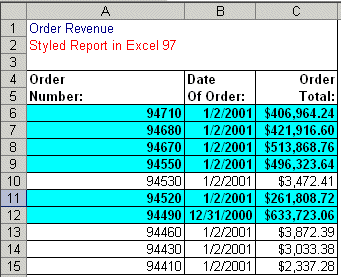
When you use Microsoft
Internet Explorer and Excel 97, the Excel client opens in the background
and the report launches in your browser. Depending on browser settings,
you may see the Excel application open and minimized while viewing
your report. Leave Excel open when viewing the spreadsheet. In Excel
97, you will be prompted to save the document as a Microsoft Excel
Workbook with an .xls extension. This saves the file as a binary
Excel document.
x
Reference: Limitations for FORMAT EXL97
- This format
is compatible only with Excel 97 or higher. It is not compatible
with Excel 95 or versions of Excel prior to Excel 95.
- While Excel
97 supports styling (StyleSheets), it does not support Cascading
Style Sheets (CSS). Styling specified in a report that uses CSS
(SET HTMLCSS=ON) will not be respected in Excel 97. The WRAP=n feature
is not supported with EXL97, since this feature requires CSS.
- Numeric and
date formatting options not supported for EXL2K are also not supported
for EXL97. In addition, negative numbers displayed with brackets
and trailing zeroes after the decimal are not supported. Note that
dates are typically translated into Excel's General format, which
may cause problems with sorting and other Excel features.
- PivotTables
are not supported with EXL97. (EXL2K PIVOT is the only valid PivotTable format.)






























